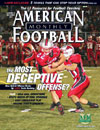AMERICAN FOOTBALL MONTHLY THE #1 RESOURCE FOR FOOTBALL COACHES
Article CategoriesAFM Magazine
|
Defending the PassDisruptions & Hand-to-Hand Combatby: Todd Howard Defensive Line Coach, UCLA © More from this issue In today’s brand of college football, teams tend to throw more than they run. In light of this trend, the coaching staff at UCLA has tried to be more creative with regard to how we coach and prepare our players to play against the pass. Also, because of his experience in the NFL, UCLA Defensive Coordinator Dewayne Walker, then with the Washington Redskins, brought information from studies done on 'Ball Disruptions.' It is well known that combining pressure on the passer with the jamming of the receivers to disrupt the timing of their patterns is an effective means for creating sacks and incomplete passes. However, an area that we give attention to is a statistic that we call “Ball Disruptions.” We define “Ball Disruptions” as an attempt by the defense to adversely affect the normal flow of an offensive pass by applyi....The full article can only be seen by subscribers. Subscribe today!
|
|
|||||||
| HOME |
MAGAZINE |
SUBSCRIBE | ONLINE COLUMNISTS | COACHING VIDEOS |
Copyright 2025, AmericanFootballMonthly.com
All Rights Reserved





